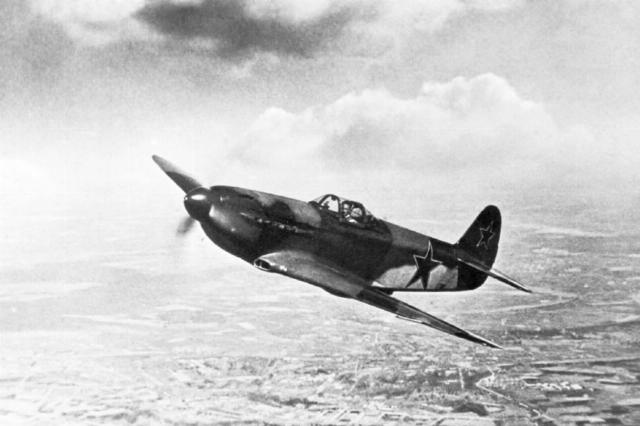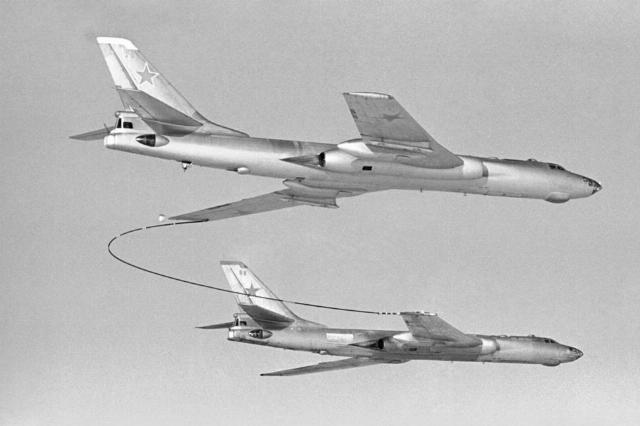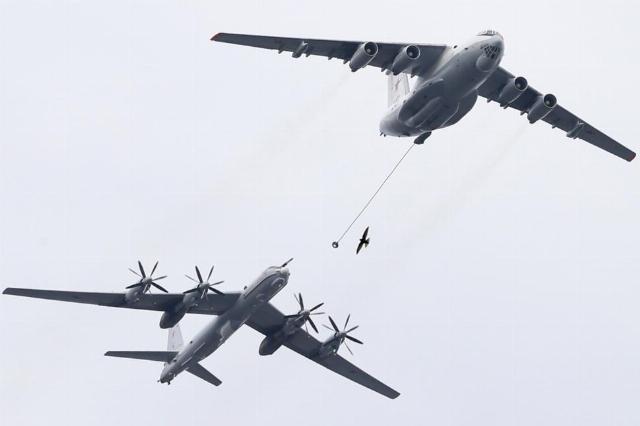Refueling in the air is a difficult and very risky element of flight. To this day, viewers of various aviation holidays and airshows are watching its implementation with bated breath. High flying skills are required from pilots, because the planes need to be brought closer to each other at a distance of 20 m, and all this at high speed.
70 years ago, in the autumn of 1954, the first test of refueling in the air of a MiG-15bis jet fighter from a Tu-4 tanker began. This important work has made it possible to increase the range of fighter flights many times, to make them reliable defenders of heavy aircraft on the way to the target.
A canister of gasoline and more
Among the first methods of refueling in the sky, of course, we can consider cases when pilots simply transferred a canister of gasoline from one slow-flying airplane to another. This was practiced, for example, as early as 1912. But it will still be difficult to call it a system. Alexander Prokofiev-Seversky, a pilot, military theorist, and then aircraft designer, proposed to "really" refuel an aircraft in the air in the Russian Empire in the summer of 1917. However, he patented this idea already in the United States in 1921, after emigrating from Soviet Russia.
In the early 1930s, various countries worked on improving the refueling system, primarily in the United Kingdom and the United States. In addition to increasing the flight range, there was another reason — reducing the weight of the aircraft during takeoff. This made it possible, for example, for bombers to take on board more bombs. At that time, the first refueling system was created using special grips and steel cables.
Among Soviet inventors, this topic was touched upon, for example, by Pavel Grokhovsky, one of the ideologists and founders of the Airborne Troops of the USSR, whose main business was the development of a variety of equipment for this type of Armed Forces. But he still did not seriously get carried away with the modernization of aircraft refueling systems in the air. But the aircraft designer, the author of the idea of a "composite aircraft" (or "link aircraft") Vladimir Vakhmistrov dealt with this issue more closely and quite successfully. He conducted his first successful experiments in 1932. However, it was not possible to bring the design to practical use then. From 1933 to 1935, under the guidance of pilot engineer Trofim Altynov, Arkady Zapanovannyj's scheme was tested. According to it, gasoline was poured from a multi-purpose single-engine biplane R-5 into a TB-1 torpedo bomber and from TB-1 into I—15 and I-16 fighters, as well as from one bomber to another. However, in all cases, the systems were recognized as unnecessarily complex, and flights were risky.
At the dawn of the jet age
We returned to the topic of aerial refueling after the Second World War. There was a particular need for effective ways to adopt the first jet fighters. Due to the huge fuel consumption by the standards of the previous generation of aircraft, the new machines had a much smaller range than their piston predecessors. For example, the Yak-15, when fully refueled at 590 kg, had a flight range of 510 km, whereas its progenitor Yak-3 — 780 km with 350 kg of fuel on board.

The Yak-3 fighter
Image source: © SDASM Archives/ Public Domain/ Wikimedia Commons
For the first time, the Soviet first-born jet aircraft were shown to the general public during the aviation parade on May 1, 1947. Then fifty MiG-9s and the same number of Yak-15s, gathered in two columns, flew along a given route over Red Square. It was a triumph of Stalin's aviation. It was decided to switch all fighter aircraft to jet technology. However, in preparation for the parade, it was necessary to choose the route especially carefully and organize the take-off of aircraft in large groups with minimal time intervals. At the same time, it seemed difficult to organize the process of retraining pilots with such a short flight duration (the solemn raid took only 23 minutes).
In early 1948, engineer Vakhmistrov, who was then serving at the Flight Research Institute of the Ministry of Aviation Industry (LII MAP), was assigned the task of developing an in-flight refueling system and bringing it to practical use. Having studied foreign experience, he settled on the principle of using a flexible hose and cables. Test pilots Igor Shelest and Viktor Vasyanin also worked at LII MAP. Observing the activities of Vakhmistrov, they, on their own initiative, developed and proposed to build a complex different from the one designed by him. The pilots believed that the refueling process should be automated and simplified as much as possible.
According to their scheme, the planes had to fly parallel to each other, which excluded the adverse effects of a satellite jet (vortex disturbance of the air due to a closely flying aircraft - from its wing, stabilizer, and other surfaces) from one to the other. The fuel was proposed to be supplied not by gravity, like Vakhmistrov's, but under pressure, which was supposed to speed up the refueling process. The system turned out to be very promising, it was approved by the management and allocated two Tu-2 bombers for experiments. A full—size mock-up of the tanker's equipment was mounted on one of them, and a mock-up of the fuel receiver was mounted on the second. On June 16, 1949, Shelest and test pilot Amet Khan Sultan performed the first airborne docking. Later, a mock-up of the fuel receiver was installed on the wing of the Yak-15 fighter and also tested in the sky. And the work on the Vakhmistrov system has not been developed.
Meanwhile, when creating the second generation of jet fighters, the designers solved the problem of flight duration — the MiG-15 had a range (without outboard tanks) of 1,330 km. But the Cold War was beginning, and the range of the Soviet Tu-4 main bomber was not enough — the potential enemy was overseas. Therefore, Shelest and Vasyanin were given the task to develop not a mock-up, but a fully functioning fuel transfer system for the Tu-4 using the wing-to-wing method, and the tanker was to serve as an aircraft of the same type. In addition, the requirement was established to ensure pumping of 35-40% of the total fuel supply in no more than 20 minutes. Two test pilots were asked to consider the issue of installing additional gas tanks in the bomb bay, and to make the fuel intake equipment extremely light so as not to limit the combat capabilities of the Tu-4.
As a result, the refueling process looked like this: a cable was released from the end of the bomber wing console, at the end of which there was a stabilizing parachute and a load representing a coupling lock; the tanker approached from behind-on the right, the end part of its left console lay on the cable and moved until the lock touched with a ring-shaped hook mounted on its lower surface. This is how the coupling was carried out. After that, a cable was pulled into the bomber wing, followed by a fuel supply hose, which was placed on the tanker aircraft along the leading edge along the entire wing span. After the hose was docked, fuel pumping began.
The system was tested by pilots Alexey Yakimov and Amet Khan Sultan. After completion of the work, the wing-to-wing refueling complex was installed on a number of serial Tu-4, and later on Tu-16. At the same time, there was no cable in the system mounted on the Tu-16, which simplified the fuel transfer process. According to the new refueling scheme, the tanker was already flying from the left to the front, and the operation began with the release of a fuel hose with a stabilizing parachute and a lock from the tip of its wing. Coupling took place in a similar way. Tanker aircraft based on the Tu-16 received the name Tu-163.

Refueling of the Tu-16 bomber
Image source: © Semyon Meisterman/ TASS
"Our preliminary calculations for refueling the serial Tu-4 from a refueling tanker, also Tu-4, showed that there are no technical difficulties to increase the range of a single aircraft with a bomb load of 2 tons to 9700 km with two refueling in the air. This range is not the limit and can be increased as a result of experimental work, even without significant design changes to the serial Tu-4. With further modification ... the range (with two or three refueling in the air) can be increased to 15 000 — 16 000 km, which will allow single aircraft — heavy bombers — to have a tactical radius (taking into account 15% of the navigation reserve) of 6000-7000 km.
When using airfields on Rudolph Island, in the Murmansk region or in the eastern part of Chukotka, Canada and most of the United States territory will be located within this radius. Thus, the use of refueling of Tu-4 aircraft in the air with refueling from the same type will allow air operations to be transferred to the territory of North America, and the 3/4 flight will take place over areas of the Arctic and the Arctic that cannot be saturated with strong air defense systems," explained in a letter from Air Force Commander Pavel Zhigarev dated April 12 1949 to the Minister of Aviation Industry Mikhail Khrunichev.
"Boatmen" in the sky
It seemed that the issue of achieving the required range could be considered resolved. But any, even well-armed bombers will suffer heavy losses if they are not covered by fighters. The Second World War only confirmed this. For example, during the raids of American "Flying Fortresses" on Europe in 1943-1944, the Nazis managed to inflict significant damage to bombers (despite their powerful defensive weapons) until they were covered by long-range Thunderbolts and Mustangs fighters along the entire route. In the USSR, even before the war, engineer Vakhmistrov implemented systems for transporting fighters on the wing or under the wing — by hanging — the TB-3 carrier aircraft, but aircraft designer Alexander Yakovlev proposed transporting fighters on a rigid coupling.
On February 22, 1949, a resolution was signed with the code "Boatmen" — the team of the Alexander Yakovlev Design Bureau was instructed to implement a new method. Undoubtedly, it was taken into account that the experienced design bureau had experience in transporting gliders on a coupling, they managed to work out several options for grabbing tow ropes in flight. But the military demanded that the system allow multiple coupling and uncoupling of aircraft. The designers, after analyzing six options for grabbing and ending the tow rope, eventually settled on the cone—harpoon system.
At first, experimental towing of the Yak-25 fighter was carried out, on which Sergei Anokhin flew behind the B-25 bomber (piloted by Valentin Khapov). They started on June 1, 1949 and lasted 16 months. In their course, nine couplings were produced, all at an altitude of about 2 thousand meters at a speed of 350 km/h. Then the pair consisted of a MiG-15bis fighter and a Tu-4 bomber. Moreover, the latter was modified: a cone was fixed to the left of the aft shooter's cabin, its cable ran along the fuselage and went inside the tail section, and a harpoon was installed on the jet fighter by analogy with the Yak-25. In March 1951, flight tests of this variant began. On October 30 of the same year, a government decree was signed on the preparation of five such "Boatmen" for military tests, which took place from July 9 to September 8, 1952 in Belarus. 142 docking operations were performed, including 17 at night. The longest duration of a single tow was 2 hours and 30 minutes, of which 2 hours and 27 minutes were with the engine turned off. No flight accidents occurred during the tests.
In the process of work, the specialists had a question — is it possible to use the cable also for refueling fuel? This is how the second stage of creating an effective algorithm for refueling in the air began. Tests of the modified system — a hose with an additional cone for a fuel intake rod combined with a harpoon - started on September 24, 1954 and ran until March 1955. During the state tests, the Mig was piloted by Anokhin, and the Tu-4 tanker aircraft was piloted by Alexander Efimov. Five contacts were made at altitudes of 2 thousand meters. m and 4 thousand meters, and three of them were pumping fuel.
But the experiment at an altitude of 8.5 thousand meters ended in failure — the rubber parts of the external components of the system froze, lost elasticity, and the docking did not take place. In addition, the military considered it unacceptable that the flight speed of the Tu-4 tow truck was significantly reduced, not allowing it to keep a place in the formation of bombers. After turning off the engine on the fighter (refueling was carried out simultaneously with towing and the aircraft could fly without the engine running), the pressurization and heating system of the cabin stopped working — the fighter pilot at altitudes of 7 thousand meters did not get a tooth on a tooth from the cold.
However, in general, the system made it possible to transport a fighter over a long distance in non-motorized flight, start the engine and cover long-range bombers, that is, solve the main task. In addition, as during previous tests, the system provided reliable in-flight refueling at low and medium altitudes.
As a result, this work was continued. Currently, the Russian military is armed with multi-purpose Il-78 and Il-78M, which are capable of servicing almost the entire Air Force fleet, including modern escort fighters. Refueling trucks have been actively used during major military exercises in recent years.

